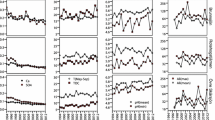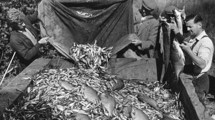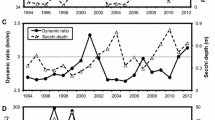Abstract
During the past 10–15 years removal of plankti- and benthivorous fish (mainly roach, Rutilus rutilus, and bream, Abramis brama) has commonly been used as a method to improve the ecological quality of Danish lakes. Here, we examine the general and long-term effects obtained after the removal of 41–1360 kg fish ha−1 in 36 mainly shallow and eutrophic lakes. In lakes in which less than 200 kg fish ha−1 were removed within a 3-year period only minor effects were observed, but at higher removal rates both chemical and biological variables were markedly affected. The concentrations of chlorophyll a (Chla), total phosphorus (TP), total nitrogen (TN), and suspended solids (SS) decreased to 50–70% of the level prior to removal. The most significant and long-lasting effects were found for SS and Secchi depth, whereas the most modest effects were seen for Chla. This probably reflects an efficient and persistent reduction of the bream stock which reduced resuspension and SS, while the biomass of roach returned to former levels, decreasing the zooplankton grazing with less control on Chla. Total algal biomass also declined after fish removal, particularly that of cyanobacteria, whereas the biomass of cryptophytes increased, indicating enhanced grazing pressure by zooplankton. The abundance and species number of submerged macrophytes increased in the majority of the lakes. For most variables the effects of the fish removal were significant for 6–10 years, after which many lakes tended to return to pre-restoration conditions, probably mainly because of consistently high external and internal phosphorus loading. We conclude that a sufficiently extensive removal of plankti- and benthivorous fish is an efficient tool to create clear water; however, repeated fish removal is presumably required to obtain long-term effects in the most nutrient rich lakes.







Similar content being viewed by others
References
Benndorf J. 1990. Conditions for effective biomanipulation—conclusions derived from whole-lake experiments in Europe. Hydrobiologia 200: 187–203
Benndorf J, Boing W, Koop J, Neubauer I. 2002. Top-down control of phytoplankton: the role of time scale, lake depth and trophic state. Freshw Biol 47: 2282–95
Blindow I, Andersson G, Hargeby A, Johansson S. 1993. Long-term pattern of alternative stable states in 2 shallow eutrophic lakes. Freshw Biol 30: 159–67
Bottrell HH, Duncan A, Gliwicz ZM, Grygierek E, Herzig A, Hillbricht-Ilkowska A, Kurasawa H, Larsson P, Weglenska T. 1976. A review of some problems in zooplankton production studies. Norw J Zool 24: 419–56
Breukelaar AW, Lammens EHHR, Klein Breteler JGB, Tatrai I. 1994, Effects of benthivorous bream (Abramis brama) and carp (Cyprius carpio) on sediment resuspension and concentration of nutrients and chlorophyll-a. Freshw Biol 32: 113–21
Carpenter SR, Kitchell JF, Hodgson JR. 1985. Cascading trophic interactions and lake productivity. BioScience 35: 634–9
Chen FZ, Xie P, Qin BQ. 2007. Different competitive outcomes among four species of cladocerans under different alga combinations of colonial Microcystis spp. and green alga Scenedesmus obliquus. Hydrobiologia 581: 209–15
Cooke GD, Welch EB, Peterson SA, Nichols SA. 2005. Restoration and management of lakes and reservoirs. 3rd ed. Boca Raton: CRC Press, Taylor & Francis Group
Coveney MF, Lowe EF, Battoe LE, Marzolf ER, Conrow R. 2005. Response of a eutrophic, shallow subtropical lake to reduced nutrient loading. Freshw Biol 50: 1718–30
Dodds WK. 2003. The role of periphyton in phosphorus retention in shallow freshwater aquatic systems. J Phycol 39: 840–9
Drenner RW, Hambright KD. 1999. Biomanipulation of fish assemblages as a lake restoration technique. Arch Hydrobiol 146: 129–65
Dumont HJ, Van De Velde I, Dumont S. 1975. The dry weight estimate of biomass in a selection of Cladocera, Copepoda and Rotifera from the plankton, periphyton and benthos of continental waters. Oecologia 19: 75–97
Edmondson WT. 1972. Nutrients and phytoplankton in Lake Washington. In: Likens GE, Ed. Nutrients and eutrophication the limiting-nutrient controversy. Spec Symp Am Soc Limnol Oceanogr 1:172–93
European Union. 2000. Directive 2000/60/EC of the European Parliament and of the Council establishing a framework for the community action in the field of water policy
Fulton RS, Pearl HW. 1988. Effects of the blue-green-alga microcystis-aeruginosa on zooplankton competitive relations. Oecologia 76: 383–9
Hansel-Welch N, Butler MG, Carlson TJ, Hanson MA. 2003. Changes in macrophyte community structure in Lake Christina (Minnesota), a large shallow lake, following biomanipulation. Aquat Bot 75: 323–37
Hansson LA. 1989. The influence of a periphytic bioloayer on phosphorus exchange between substrate and water. Arch Hydrobiol 115: 21–6
Hansson LA, Annadotter H, Bergman E, Hamrin SF, Jeppesen E, Kairesalo T, Luokkanen E, Nilsson P-Å, Søndergaard M, Strand J. 1998. Biomanipulation as an application of food-chain theory: constraints, synthesis, and recommendations for temperate lakes. Ecosystems 1: 558–74
Hanson MA, Butler MG. 1994. Responses of plankton, turbidity and macrophytes to biomanipulation in a shallow prairie lake. Can J Fish Aquat Sci 41: 1180–8
Hargeby A, Blindow I, Andersson G. 2007. Long-term patterns of shifts between clear and turbid states in Lake Krankesjon and Lake Takern. Ecosystems 10: 28–35
Hartley AM, House WA, Callow ME, Leadbeater BSC 1997. Coprecipitation of phosphate with calcite in the presence of photosynthesizing green algae. Water Res 31: 2261–8
Hilt S. 2006. Recovery of Potamogeton pectinatus L. stands in a shallow eutrophic lake under extreme grazing pressure. Hydrobiologia 570: 95–9
Ibelings BW, Portielje R, Lammens EHRR, Noordhuis R, van den Berg MS, Joosse W, Meijer ML. 2007. Resilience of alternative stable states during the recovery of shallow lakes from eutrophication: Lake Veluwe as a case study. Ecosystems 10: 4–16
Jeppesen E, Jensen JP, Kristensen P, Søndergaard M, Mortensen E, Sortkjær O, Olrik K. 1990. Fish manipulation as a lake restoration tool in shallow, eutrophic, temperate lakes 2: threshold levels, long-term stability and conclusions. Hydrobiologia 200/201: 219–27
Jeppesen E, Jensen JP, Søndergaard M, Fenger-Grøn M, Sandby S, Hald Møller P, Rasmussen HU. 2004. Does fish predation influence zooplankton community structure and grazing during winter in north-temperate lakes? Freshw Biol 49: 432–47
Jeppesen E, Jensen JP, Søndergaard M, Lauridsen T, Landkildehus F. 2000. Trophic structure, species richness and biodiversity in Danish lakes: changes along a phosphorus gradient. Freshw Biol 45: 201–13
Jeppesen E, Jensen JP, Windolf J, Lauridsen T, Søndergaard M, Sandby K, Hald Møller P. 1998. Changes in nitrogen retention in shallow eutrophic lakes following a decline in density of cyprinids. Arch Hydrobiol 142: 129–52
Jeppesen E, Sammalkorpi I. 2002. Lakes. In: Perrow M, Davy, T, Eds. Handbook of restoration ecology, vol. 2. Cambridge: Cambridge University Press
Jeppesen E, Søndergaard M, Jensen JP, Havens KE, Anneville O, Carvalho L, Coveney MF, Deneke R, Dokulil MT, Foy B, Gerdeaux D, Hampton SE, Hilt S, Kangur K, Köhler J, Lammens EHHR, Lauridsen TL, Manca M, Miracle MR, Moss B, Nõges P, Persson G, Phillips G, Portielje R, Schelske CL, Straile D, Tatrai I, Willén E, Winder M. 2005. Lake responses to reduced nutrient loading—an analysis of contemporary long-term data from 35 case studies. Freshw Biol 50: 1747–71
Jeppesen E, Søndergaard M, Kronvang B, Jensen JP, Svendsen LM, Lauridsen T. 1999. Lake and catchment management in Denmark. Hydrobiologia 395/396: 419–32
Jeppesen E, Søndergaard M, Lauridsen TL, Kronvang B, Beklioglu M, Lammens E, Köhler J, Ventelä AM, Tarvainen M, Tátrai I. 2007. Danish and some other European experiences in managing shallow lakes. Lake Res Manag 23: 439–51
Jeppesen E, Søndergaard M, Søndergaard M, Christoffersen K, Eds. 1997. The structuring role of submerged macrophytes in Lakes. Ecological studies, vol. 131. Springer Verlag, 423 pp
Jespersen AM, Christoffersen K. 1987. Measurements of chlorophyll a from phytoplankton using ethanol as extraction solvent. Arch Hydrobiol 109: 445–54
Kalbfleisch JD, Prentice RL. 1980. The statistical analysis of failure time data. New York: John Wiley & Sons
Kronvang B, Ærtebjerg G, Grant R, Kristensen P, Hovmand M, Kirkegaard J. 1993. Nationwide Danish monitoring programme—state of the aquatic environment. Ambio 22: 176–87
Kronvang B, Jeppesen E, Conley DJ, Søndergaard M, Larsen SE, Ovesen NB, Carstensen J. 2005. Nutrient pressures and ecological responses to nutrient loading reductions in Danish streams, lakes and coastal waters. J Hydrol 304: 274–88
Lauridsen TL, Sandsten H, Møller PH. 2003. The restoration of a shallow lake by introducing Potamogeton spp. The impact of waterfowl grazing. Lakes & Reservoirs: Res Manag 8: 177–87
Liboriussen L, Søndergaard M, Jeppesen E, Eds. 2007. Sørestaurering i Danmark. Report No. 636 from the National Environmental Institute, University of Aarhus. 86 p. (In Danish)
Lougheed VL, Theysmeyer TS, Smith T, Chow-Fraser P. 2004. Carp exclusion, food-web interactions, and the restoration of Cootes Paradise Marsh. J Great Lakes Res 30: 44–57
Mehner T, Benndorf J, Kasprzak P, Koschel R. 2002. Biomanipulation of lake ecosystems: successful applications and expanding complexity in the underlying science. Freshw Biol 47: 2453–65
Meijer ML, de Boois I, Scheffer M, Portielje R, Hosper H. 1999. Biomanipulation in shallow lakes in The Netherlands: an evaluation of 18 case studies. Hydrobiologia 409: 13–30
Mortimer CH. 1941. The exchange of dissolved substances between mud and water in lakes. I. J Ecol 29:280–329
Moss B. 1990. Engineering and biological approaches to the restoration from eutrophication of shallow lakes in which aquatic plant-communities are important components. Hydrobiologia 200: 367–77
Olin M, Rask M, Ruuhijarvi J, Keskitalo J, Horppila J, Tallberg P, Taponen T, Lehtovaara A, Sammalkorpi I. 2006. Effects of biomanipulation on fish and plankton communities in ten eutrophic lakes of southern Finland. Hydrobiologia 553: 67–88
Penn MR, Auer MT, Doerr SM, Driscoll CT, Brooks CM, Effler SW. 2000. Seasonality in phosphorus release rates from the sediments of a hypereutrophic lake under a matrix of pH and redox conditions. Can J Fish Aquat Sci 57: 1033–41
Perrow MR, Davy AJ. 2002. Handbook of ecological restoration, vol. 1: principles of restoration. Cambridge: Cambridge University Press
Phillips G, Kelly A, Pitt J-A, Sanderson R, Taylor E. 2005. The recovery of Barton Broad, a very shallow eutrophic lake, 20 years after the control of effluent derived phosphorus. Freshw Biol 50: 1628–38
Roozen FCJM, Lurling M, Vlek H, Kraan EAJVP, Ibelings BW, Scheffer M. 2007. Resuspension of algal cells by benthivorous fish boosts phytoplankton biomass and alters community structure in shallow lakes. Freshw Biol 52: 977–87
Rørslett B, Berge D, Johansen SW. 1985. Mass invasion of Elodea canadensis in a mesotrophic, South Norwegian lake—impact on water quality. Ver Int Ver Theor Angew Limnol 22: 2920–6
Sas H, Ed. 1989. Lake restoration by reduction of nutrient loading. Expectation, experiences, extrapolation. St. Augustin: Academia Verlag Richardz GmbH
Scheffer M, Hosper SH, Meijer M-L, Moss B, Jeppesen E. 1993. Alternative equilibria in shallow lakes. Trends Ecol Evol 8: 275–9
Scheffer M, Portielje R, Zambrano L. 2003. Fish facilitate wave resuspension of sediment. Limnol Oceanogr 48: 1920–6
Schriver P, Bøgestrand J, Jeppesen E, Søndergaard M. 1995. Impact of submerged macrophytes on fish-zooplankton-phytoplankton interactions: large-scale enclosure experiments in a shallow eutrophic lake. Freshw Biol 33: 255–70
Skov C, Nilsson PA. 2007. Evaluating stocking of YOY pike Esox lucius as a tool in the restoration of shallow lakes. Freshw Biol 52: 1834–45
Søndergaard M, Bruun L, Lauridsen TL, Jeppesen E, Vindbæk Madsen T. 1996. The impact of grazing waterfowl on submerged macrophytes. In situ experiments in a shallow eutrophic lake. Aquat Bot 53: 73–84
Søndergaard M, Jensen JP, Jeppesen E. 2003. Role of sediment and internal loading of phosphorus in shallow lakes. Hydrobiologia 506/509: 135–45
Søndergaard M, Jensen JP, Jeppesen E. 2005. Seasonal response of nutrients to reduced phosphorus loading in 12 Danish lakes. Freshw Biol 50: 1605–15
Søndergaard M, Jeppesen E, Lauridsen TL, Skov C, Van Nes EH, Roijackers R, Lammens E, Portielje R. 2007. Lake restoration: successes, failures and long-term effects. J Appl Ecol 44: 1095–105
Søndergaard M, Jeppesen E, Mortensen E, Dall E, Kristensen P, Sortkjær O. 1990. Phytoplankton biomass reduction after planktivorous fish reduction in a shallow, eutrophic lake: a combined effect of reduced internal P-loading and increased zooplankton grazing. Hydrobiologia 200/201: 229–40
Søndergaard M, Kristensen P, Jeppesen E. 1992. Phosphorus release from resuspended sediment in the shallow and wind exposed Lake Arresø, Denmark. Hydrobiologia 228: 91–9
Spears BM, Carvalho L, Perkins R, Kirika A, Paterson DM. 2007. Sediment phosphorus cycling in a large shallow lake: spatio-temporal variation in phosphorus pools and release. Hydrobiologia 584: 37–48
Strand JA, Weisner SEB. 2001. Dynamics of submerged macrophyte populations in response to biomanipulation. Freshw Biol 46: 1397–408
Tarvainen M, Ventela AM, Helminen H, Sarvala J. 2005. Nutrient release and resuspension generated by ruffe (Gymnocephalus cernuus) and chironomids. Freshw Biol 50: 447–58
ter Heerdt G, Hootsmans M. 2007. Why biomanipulation can be effective in peaty lakes. Hydrobiologia 584: 305–16
Van De Bund WJ, Van Donk E. 2002. Short-term and long-term effects of zooplanktivorous fish removal in a shallow lake: a synthesis of 15 years of data from Lake Zwemlust. Freshw Biol 47: 2380–7
Welch EB, Cooke GD. 2005. Internal phosphorus loading in shallow lakes: importance and control. Lake Res Manag 21: 209–17
Yang XE, Wu X, Hao HL, He ZL. 2008. Mechanisms and assessment of water eutrophication. J Zhejiang Univ Sci B 9: 197–209
Acknowledgments
We wish to thank Anne Mette Poulsen and Tinna Christensen at the National Environmental Research Institute, University of Aarhus, Silkeborg, for editorial and layout assistance. We also thank the former Danish counties for access to the data used in the analyses. The study was supported by the EU EUROLIMPACS project (http://www.eurolimpacs.ucl.ac.uk) on the effects of climate changes on aquatic ecosystems and the Danish Centre for Lake Restoration (CLEAR—a VILLUM KANN RASMUSSEN Centre of Excellence project).
Author information
Authors and Affiliations
Corresponding author
Additional information
Author Contributions: M.S. wrote the article and participated in the data analyses. L.L. prepared and analyzed data and commented on the manuscript. A.R.P. performed the statistical analyses (survival analyses). E.J. analyzed data and gave input on the manuscript.
Rights and permissions
About this article
Cite this article
Søndergaard, M., Liboriussen, L., Pedersen, A.R. et al. Lake Restoration by Fish Removal: Short- and Long-Term Effects in 36 Danish Lakes. Ecosystems 11, 1291–1305 (2008). https://doi.org/10.1007/s10021-008-9193-5
Received:
Revised:
Accepted:
Published:
Issue Date:
DOI: https://doi.org/10.1007/s10021-008-9193-5




